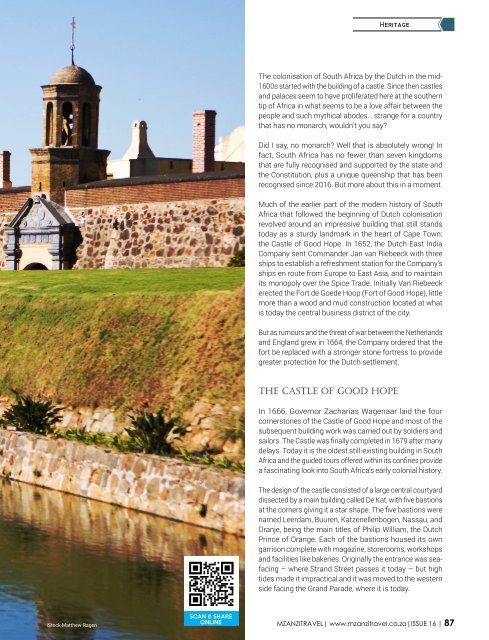MZANZI ISSUE 16
Create successful ePaper yourself
Turn your PDF publications into a flip-book with our unique Google optimized e-Paper software.
Heritage<br />
The colonisation of South Africa by the Dutch in the mid-<br />
<strong>16</strong>00s started with the building of a castle. Since then castles<br />
and palaces seem to have proliferated here at the southern<br />
tip of Africa in what seems to be a love affair between the<br />
people and such mythical abodes… strange for a country<br />
that has no monarch, wouldn’t you say?<br />
Did I say, no monarch? Well that is absolutely wrong! In<br />
fact, South Africa has no fewer than seven kingdoms<br />
that are fully recognised and supported by the state and<br />
the Constitution, plus a unique queenship that has been<br />
recognised since 20<strong>16</strong>. But more about this in a moment.<br />
Much of the earlier part of the modern history of South<br />
Africa that followed the beginning of Dutch colonisation<br />
revolved around an impressive building that still stands<br />
today as a sturdy landmark in the heart of Cape Town:<br />
the Castle of Good Hope. In <strong>16</strong>52, the Dutch East India<br />
Company sent Commander Jan van Riebeeck with three<br />
ships to establish a refreshment station for the Company’s<br />
ships en route from Europe to East Asia, and to maintain<br />
its monopoly over the Spice Trade. Initially Van Riebeeck<br />
erected the Fort de Goede Hoop (Fort of Good Hope), little<br />
more than a wood and mud construction located at what<br />
is today the central business district of the city.<br />
But as rumours and the threat of war between the Netherlands<br />
and England grew in <strong>16</strong>64, the Company ordered that the<br />
fort be replaced with a stronger stone fortress to provide<br />
greater protection for the Dutch settlement.<br />
The Castle of Good Hope<br />
In <strong>16</strong>66, Governor Zacharias Wagenaar laid the four<br />
cornerstones of the Castle of Good Hope and most of the<br />
subsequent building work was carried out by soldiers and<br />
sailors. The Castle was finally completed in <strong>16</strong>79 after many<br />
delays. Today it is the oldest still-existing building in South<br />
Africa and the guided tours offered within its confines provide<br />
a fascinating look into South Africa’s early colonial history.<br />
The design of the castle consisted of a large central courtyard<br />
dissected by a main building called De Kat, with five bastions<br />
at the corners giving it a star shape. The five bastions were<br />
named Leerdam, Buuren, Katzenellenbogen, Nassau, and<br />
Oranje, being the main titles of Philip William, the Dutch<br />
Prince of Orange. Each of the bastions housed its own<br />
garrison complete with magazine, storerooms, workshops<br />
and facilities like bakeries. Originally the entrance was seafacing<br />
– where Strand Street passes it today – but high<br />
tides made it impractical and it was moved to the western<br />
side facing the Grand Parade, where it is today.<br />
iStock-Matthew Ragen<br />
SCAN & SHARE<br />
ONLINE<br />
<strong>MZANZI</strong>TRAVEL| www.mzanzitravel.co.za|<strong>ISSUE</strong> <strong>16</strong> | 87
















